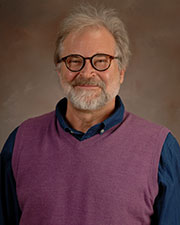NIH renews Dowhan, Bogdanov’s 50-year grant

The National Institutes of Health(NIH) has granted William Dowhan, PhD, and Mikhail Bogdanov, PhD, professors in the Department of Biochemistry and Molecular Biology, a renewal for their grant titled “Dynamic Lipid and Protein Organization in Cell Membranes.”
The renewal is a Multi-Principal Investigator Award recognizing the equal contributions of Dowhan and Bogdanov. The project had its early beginnings 50 years ago when Dowhan joined the faculty and focused his studies on the biosynthesis and assembly of the phospholipid component of cell membranes.
Nearly two decades later, Bogdanov joined the project and added his expertise in studies of both phospholipids and membrane proteins. Phospholipids organize into a bilayer barrier, which separates the inside from the outside of cells and organelles. This lipid barrier is the matrix in which membrane proteins either insert or associate with to define a functional membrane and regulate the entry and exit of metabolites, drugs, and viruses.

“Membrane lipids are actively involved in a variety of processes besides their canonical barrier role,” the researchers said. “These diverse functions are made possible by a family of chemically, structurally, and conformationally different lipid molecules that are physically fluid and deformable to enable permanent and transient interaction in a flexible and specific manner with themselves and the protein component of the membrane.”
Non-canonical roles for lipids acting as molecular chaperones and protein topological determinants were established by Bogdanov and Dowhan, which expanded the understanding of lipid involvement in cellular processes. Over 70 percent of current drugs target a membrane associated with cellular function. Therefore, how the lipid barrier is formed and interacts with the membrane protein component is central to understanding normal and aberrant cell function.
During their long-term collaboration, novel methodologies and concepts were developed to establish that cell membranes are not static structures. Both the lipid and protein components are in a dynamic organization where both components can “flip” with the membrane superstructure to expose different parts to the inside or outside of cells and organelles in response to internal and external signals.
The lipid bilayer was widely considered a ‘non-flipping’ zone for integral membrane proteins because of the presumed high energy barrier to flipping, i.e., once assembled in the membrane their organization and orientation in the membrane were assumed to be fixed. The duo established that a subset of proteins could adopt dual orientation or alter their orientation in the membrane in response to changes in membrane lipid composition or cell physiology, which is contrary to the long-standing dogma in membrane biology.
Together, they established the Change Balance Rule, which incorporates the importance of lipid-protein interactions into the long-accepted Positive Inside Rule that governs membrane protein structural organization. An effective drug design is dependent on understanding membrane protein structure and all the rules governing the folding and assembly of native membrane proteins.
This novel dynamic aspect of membrane organization uncovered new modes of cellular regulation and provides a mechanism whereby the same gene product can express multiple functions depending on lipid-dependent protein orientation in the membrane.
“The current grant builds on the general principles established over the past 50 years of NIH funding and will investigate how lipid-protein interaction affects specific cellular processes as well as the physiological significance of the flip-flipping membrane protein phenomenon,” the investigators said. “The grant utilizes our development of novel methodologies for determining static and dynamic orientation and distribution of lipids and proteins in the membrane.”
Of particular focus for the team are the membrane phospholipids, phosphatidylethanolamine, which sets a threshold level for the flip ability of structurally unrelated membrane proteins, and cardiolipin, which is important in bacterial resistance to antibiotics as well as the support of many essential cellular processes.
“The grant provides the necessary funding for supplies and personnel,” the researchers said. “In addition, the resources of the Center for Membrane Biology and the Structural Biology Imaging Center will provide important University support. Of course, none of the progress would have been possible without the input by many talented graduate students, postdoctoral fellows, and technicians. Also, the department, Medical School, and the John Dunn Research Foundation have provided additional support for this long-running project.”